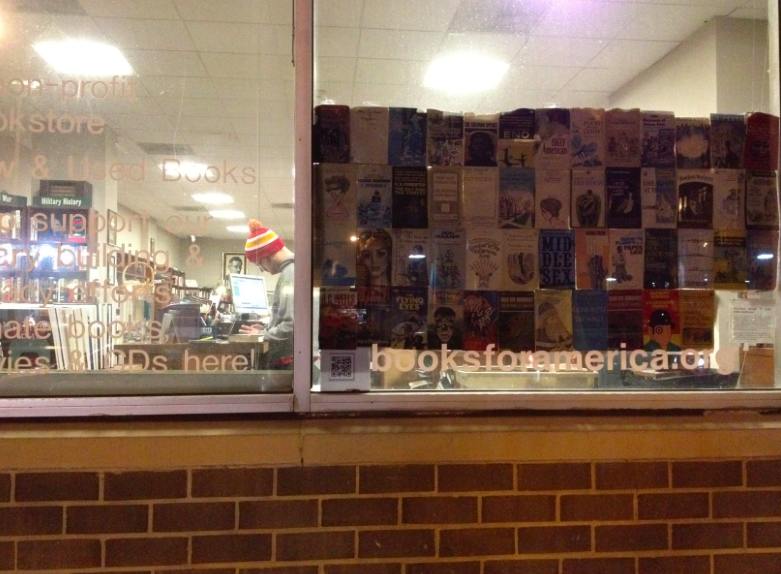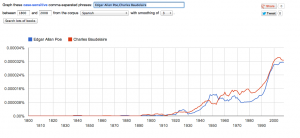I wanted to write a last post about some ideas I had and things that happened to me during the course. I wanted to share them with you and I thought that this was the best place to do that.
I enrolled in this course because of the reasons we were and are studying, especially in this last section. I was curious about DH because I like to build and transform things inside the field of literary studies. And I liked the fact that I can do something else in academia more than just writing papers, and I can share my writings with people I knew and unknowns, that they can help me writing and exposing ideas, that I can be creative with the way I presented my ideas, not just written ideas (without having to be a designer), and being in touch with a lot of things that are happening right NOW in many disciplines, especially literature.
I never liked the way I studied at the academia, at least in Latin American literature (I do not think English is very different). It was too closed to things that were happening (especially in literature!), I thought that having a publishing house, a literary magazine, even a bookstore was a better idea – but I do not have a commercial spirit and I would have sunk. I have always been tempted to drop my classes: it is a debate I had to myself since an undergrad. But here I am, pursuing a PhD degree! I do not think I would have done the same If I had stayed in Argentina, because one of the things that seduced me the most to go on my studies here was my curiosity about American academy, what was trendy, and the possibility of dialoguing with current theories and critics. I thought it would be a great opportunity to listen to different ideas, and study how they circulate in the powerful countries, and the place that Latin America had there.
When I began studying here, I realized that it wasn’t that different and that professors still were reading Derrida, Foucault, Barthes, (Rancière as a relatively new member of the circle) which I find all very interesting but I am really tired of listening always to the same approach to literature. I was disappointed. More years of studying the same, saying the same, producing the same! (The biggest difference between American universities and ours is that you have to produce A LOT! With no real time to produce a real idea). I always liked to intervene instead of just producing for a certificate, a title, etc., I liked to think about my work as a work of intervention, of transformation of a certain field. That is why I began studying for being an editor, and also began translating literature from Portuguese into Spanish, and that’s why I found Internet as a great medium to publish.
So I decided to develop a site and thought of it as a digital project as part of my academic work (actually, I just wanted an “excuse” for doing my web page and whenever someone asked me “But really, why do you do this?” I could answer “Oh, it is just part of my research for the university” not having thus to justify I was doing something because I felt I had to, with any visible gain). And it was then when I finally discovered something interesting for me in academia: Digital Humanities. It was a different way to approach reading, writing, authorship, literary criticism, publishing. The digital texts denaturalized our conceptions of book and scholarship, and our whole written culture. New theories have been and are written now, new discussions not only about new materiality and a new culture, but also about pre-digital written culture.
When I went with this these ideas to my Spanish and Portuguese department, I thought the reaction would be worst. But many of my department’s professors showed interest in DH. Even though it was very common that some professors found my project very shallow, nothing to do with academy, and dismissed it.
When I presented my web page at a Graduate Student Conference, the discussant, from History department, with a very disdainful expression asked me: “How can you be talking about internet when some parts of Brazil do not even have electricity, when poor areas like favelas do not have internet?” He totally loosed the point. He said he did not like to spend hours online and that the digital was not a revolution at all. So I answered him with a question: “Do you know how much does it cost a book in Brazil? Much more than hours in an Internet café for those who do not have access at home. Nowadays, it is easier for a poor person to have access to internet in Brazil than buying a book, an object that was and still is made for the elite. Almost nobody reads literature in Brazil because literature is not where people are.” It is a lot of ignorance and arrogance! This kind of professors is very common in Spanish and Portuguese departments, sadly. They long for those days when books were only made with paper. But digital publishing is not a threat because it changes the smell of literature. The problem is that it threatens a whole idea of knowledge and power. All topics that Fitzpatrick very intelligently approached in her Planned Obsolescence, a programmatic essay, a real call to action sometimes!
Books were a sign of power. A privilege in the pre digital written culture, especially in countries like mine, where it is difficult to get books from the rest of the world. It was very common to listen to (and to believe) professors that were the only ones that had access to texts. But not anymore. I can check what the professor is saying, I can read what the world is reading, and I can participate in all kind of debates. And that is the threat. They do not have the library for themselves. And I like the way digital is disorganizing knowledge and power in academia. Last week, I attended a conference of one of the most important intellectuals in Latin America. He told us that Humanities were in crisis, that nobody was interested in it anymore. The legacy he gave to future scholars was just a debris, and that kind of speech (very common, indeed and very depowering) is limiting and useless: it is as if we have nothing to debate, therefore, those professors pitied us. When I talked to him about Digital Humanities, he did not even know what I was talking about. He looked interested (for some seconds or so) but he did not know what to answer. I liked that. I like when a professor remains in silence. It is a little kind of revenge.
Among some voices that still fight against digital (or at least feel bewildered about digital scholarship, or digital authorship, those “new modes of authorship” that Fitzpatrick mentions) and others that find it interesting and new, I decided last week, backed by my thesis director, to present a digital based project for my PhD dissertation. Digital projects are a different kind of scholar genre; no, they are more than that, they are cultural objects. They are like books that do not follow any MLA guide (great!). And any reviewer or professors of the thesis committee should be clever (maybe sensitive?) enough to read it.
So, I am really happy I was encouraged by the readings we had in this course during the semester and the classes and the exercises to begin developing my own ideas and my place in academia. I didn’t think my thesis director was going to let me present a “digital thesis”, but she was glad I was going to begin something so different in the Spanish and Portuguese department, and not only at the UMD, but also in Latin America. As there are not digital-based thesis, at least in Argentina, and DH is a field almost unknown and underdeveloped in academia, although there are people working in similar things.
I am really thankful for having been pushed to be in touch with other DHers, because I found many people in Brazil and Argentina that are working in the DH field. And now I have a place and a group of people with whom I am going to collaborate from now on.
I also found a group called GO::DH, with people from all over the world that do an incredible work spreading DH around the world, I am amazed at all they do. I am participating translating into Spanish!
So thanks to this class, I can finally be glad of being part of the academia, but more than that, I can change it.
My digital project will improve the page I created in many different ways, and I will use some of the tools we experimented in the course (of course, Twine!!!). I will be in Brazil, in a city there is nothing or near to nothing to do (you can imagine that: I found a blog which name is “How not to die of boredom in Brasilia”), and I hope I can be still in touch with you.
What I like about DH is that our questions and ideas are never in the hands of a few but are discussed among many people, that can be from different countries and speak different languages, as you and me.

























